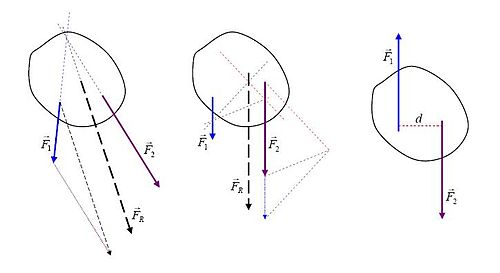Rossby number

Resultant forces refers to the reduction of a system of forces acting on a body to a single force and an associated torque. The choice of the point of application of the force determines the associated torque.[1] The term resultant force should be understood to refer to both the forces and torques acting on a rigid body, which is why some use the term resultant force-torque.
The resultant force, or resultant force-torque, fully replaces the effects of all forces on the motion of the rigid body they act upon.
Associated torque
If a point R is selected as the point of application of the resultant force F of a system of n forces Fi then the associated torque T is determined from the formulas
and
It is useful to note that the point of application R of the resultant force may be anywhere along the line of action of F without changing the value of the associated torque. To see this add the vector kF to the point of application R in the calculation of the associated torque,
The right side of this equation can be separated into the original;formula for T plus the additional term including kF,
Now because F is the sum of the vectors Fi this additional term is zero, that is
and the value of the associated torque is unchanged.
Torque-free resultant
it is useful to consider whether there is a point of application R such that the associated torque is zero. This point is defined by property
where F is resultant force and Fi form the system of forces.
Notice that this equation for R has a solution only if the sum of the individual torques on the right side yield a vector that is perpendicular to F. Thus, the condition that a system of forces has a torque-free resultant can be written as
If this condition is not satisfied, then the system of forces includes a pure torque.
The diagram illustrates simple graphical methods for finding the line of application of the resultant force of simple planar systems.
- Lines of application of the actual forces and on the leftmost illustration intersect. After vector addition is performed "at the location of ", the net force obtained is translated so that its line of application passes through the common intersection point. With respect to that point all torques are zero, so the torque of the resultant force is equal to the sum of the torques of the actual forces.
- Illustration in the middle of the diagram shows two parallel actual forces. After vector addition "at the location of ", the net force is translated to the appropriate line of application, where it becomes the resultant force . The procedure is based on decomposition of all forces into components for which the lines of application (pale dotted lines) intersect at one point (the so-called pole, arbitrarily set at the right side of the illustration). Then the arguments from the previous case are applied to the forces and their components to demonstrate the torque relationships.
- The rightmost illustration shows a couple, two equal but opposite forces for which the amount of the net force is zero, but they produce the net torque where is the distance between their lines of application. This is "pure" torque, since there is no resultant force.
Wrench
The forces and torques acting on a rigid body can be assembled into the pair of vectors called a wrench.[2] Let P be the point of application of the force F and let R be the vector locating this point in a fixed frame. Then the pair of vectors W=(F, R×F) is called a wrench. Vectors of this form are known as screws and their mathematics formulation is called screw theory.[3][4]
The resultant force and torque on a rigid body obtained from a system of forces Fi i=1,...,n, is simply the sum of the individual wrenches Wi, that is
Notice that the case of two equal but opposite forces F and -F acting at points A and B respectively, yields the resultant W=(F-F, A×F - B× F) = (0, (A-B)×F). This shows that wrenches of the form W=(0, T) can be interpreted as pure torques.
References
43 year old Petroleum Engineer Harry from Deep River, usually spends time with hobbies and interests like renting movies, property developers in singapore new condominium and vehicle racing. Constantly enjoys going to destinations like Camino Real de Tierra Adentro.
- ↑ H. Dadourian, Analytical Mechanics for Students of Physics and Engineering, Van Nostrand Co., Boston, MA 1913
- ↑ R. M. Murray, Z. Li, and S. Sastry, A Mathematical Introduction to Robotic Manipulation, CRC Press, 1994
- ↑ R. S. Ball, The Theory of Screws: A study in the dynamics of a rigid body, Hodges, Foster & Co., 1876
- ↑ J. M. McCarthy and G. S. Soh, Geometric Design of Linkages. 2nd Edition, Springer 2010












